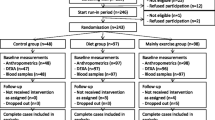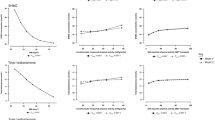Abstract
Objectives: Physical activity has demonstrable effects on estrogen levels in pre- and postmenopausal women. Increased oxidation of estrone to 2-hydroxyestrone (2HE) relative to 16α-hydroxyestrone (16HE) has been hypothesized to reduce breast cancer risk, but little is known about the effect of physical activity and body size in relation to the ratio of 2HE and 16HE in women. We examined these relationships in cross-sectional analyses of 157 North American and Chinese women.
Methods: Physical activity was assessed using validated questionnaires. Adiposity was assessed as body mass index (BMI, kg/m2) and by anthropometric methods (% body fat). Estrone metabolites, 2HE and 16HE, were determined from urine via ELISA.
Results: Regression analyses on the 2HE/16HE ratio revealed an interaction between leisure-time physical activities and adiposity in both North American and Chinese women (p≤ 0.05). Women reporting low levels of leisure-time physical activity who had higher BMI levels had 2HE/16HE ratios that were lower than their lean counterparts. In contrast, women with higher BMI levels that were physically active maintained higher 2HE/16HE ratios.
Conclusion: These findings suggest that physical activity participation has the potential to modify the adverse effect of increased adiposity on estrogen metabolism in North American and Chinese women.
Similar content being viewed by others
References
Friedenreich CM (2001) Physical activity and cancer prevention: from observational to intervention research. Cancer Epidemiol Biomarkers Prevent 10: 287–301.
International Agency for Research on Cancer (2002) Weight Control and Physical Activity. Lyon: International Agency for Research on Cancer.
Byers T, Nestle M, McTiernan A et al.(2002) American cancer society guidelines on nutrition and physical activity for cancer prevention: reducing the risk for cancer with healthy food choices and physical activity. CA: A Cancer J Clin 52: 92–119.
Hoffman-Goetz L, Apter D, Demark-Wahnefried W, Goran MI, McTiernan A, Reichman ME (1998) Possible mechanisms mediating an association between physical activity and breast cancer. Cancer 83: 621–628.
Pike MC, Spicer DV, Dahmoush L, Press MF (1993) Estrogens, progestogens, normal breast cell proliferation, and breast cancer risk. Epidemiol Rev 15: 17–35.
De Souza MJ, Miller BE, Loucks AB, et al. (1998) High frequency of luteal phase deficiency and anovulation in recreational women runners: blunted elevation in follicle-stimulating hormone observed during luteal-follicular transition. J Clin Endocrinol Metab 83: 4220–4232.
Loucks AB, Mortola JF, Girton L, Yen SC (1989) Alterations in the hypothalamic-pituitary-ovarian and hypothalamic-pituitaryadrenal axes in athletic women. J Clin Endocrinol Metab 68: 402–411.
Cauley JA, Gutai JP, Kuller LH, LeDonne D, Powell JG (1989) The epidemiology of serum sex hormones in postmenopausal women. Amer J Epidemiol 129: 1120–1131.
Zhu BT, Conney AH (1998) Functional role of estrogen metabolism in target cells: review and perspectives. Carcinogenesis 19: 1–27.
Coker AL, Crane MM, Sticca RP, Sepkovic DW (1997) Re: Ethnic differences in estrogen metabolism in healthy women. J Natl Cancer Inst 89: 89.
Ho GH, Luo XW, Ji CY, Foo SC, Ng EH (1998) Urinary 2/16 alpha-hydroxyestrone ratio: correlation with serum insulinlike growth factor binding protein-3 and a potential biomarker of breast cancer risk. Ann Acad Med, Singapore 27: 294–299.
Kabat GC, Chang CJ, Sparano JA, et al.(1997) Urinary estrogen metabolites and breast cancer: a case-control study. Cancer Epidemiol, Biomarkers Prevent 6: 505–509.
Meilahn EN, De Stavola B, Allen DS, et al. (1998) Do urinary oestrogen metabolites predict breast cancer? Guernsey III cohort follow-up. Brit J Cancer 78: 1250–1215.
Schneider J, Kinne D, Fracchia A, et al.(1982) Abnormal oxidative metabolism of estradiol in women with breast cancer. Proc Nat Acad Sci USA 79: 3047–3051.
Zheng W, Dunning L, Jin F, Holtzman J (1998) Correspondence re: G.C. Kabat et al, Urinary estrogen metabolites and breast cancer: a case-control study. Cancer Epidemiol Biomarkers Prevent 7: 85–86.
Fowke JH, Dai Q, Bradlow HL, et al.(2003) Urinary estrogen metabolites and breast cancer: differential pattern of risk found with pre-versus post-treatment collection. Steroids 68: 65–72.
Ursin G, London S, Stanczyk FZ, et al.(1999) Urinary 2-hydroxyestrone/ 16alpha-hydroxyestrone ratio and risk of breast cancer in postmenopausal women. J Natl Cancer Inst 91: 1067–1072.
De Cree C, Ball P, Seidlitz B, Van Kranenburg G, Geurten P, Keizer HA (1997) Effects of a training program on resting plasma 2-hydroxycatecholestrogen levels in eumenorrheic women. J Appl Physiol 83: 1551–1556.
Snow RC, Barbieri RL, Frisch RE (1989) Estrogen 2-hydroxylase oxidation and menstrual function among elite oarswomen. J Clin Endocrinol Metab 69: 369–376.
Pasagian-Macauley A, Meilahn EN, Bradlow HL, et al. (1996) Urinary markers of estrogen metabolism 2-and 16-alpha hydroxylation in premenopausal women. Steroids 61: 461–467.
Fishman J, Boyar RM, Hellman L (1975) Influence of body weight on estradiol metabolism in young women. J Clin Endocrinol Metab 41: 989–991.
Schneider J, Bradlow HL, Strain G, Levin J, Anderson K, Fishman J (1983) Effects of obesity on estradiol metabolism: decreased formation of nonuterotropic metabolites. J Clin Endocrinol Metab 56: 973–978.
Fowke JH, Longcope C, Hebert JR (2001) Macronutrient intake and estrogen metabolism in healthy postmenopausal women. Breast Cancer Res Treat 65: 1–10.
Gao YT, Shu XO, Dai S, et al. Association of menstrual and reproductive factors with breast cancer risk: results from the Shanghai Breast Cancer Study. Int J Cancer.
Matthews CE, Shu XO, Jin F, et al.(2001) Lifetime physical activity and breast cancer risk in the Shanghai Breast Cancer Study. Brit J Cancer 84: 994–1001.
Baecke J, Burema J, Frijters J (1982) A short questionnaire for the measurement of habitual physical activity in epidemiological studies. American J Clin Nutr 36: 936–942.
Voorips L, Ravelli A, Dongelmans P, Durenberg P, Stavren WV (1991) A Physical activity questionnaire for the elderly. Med Sci Sports Exercise 23: 974–979.
Ainsworth B, Haskell W, Leon A, et al.(1993) Compendium of physical activities: classification of energy costs of human physical activities. Med Sci Sports Exercise 25: 71–80.
Matthews CE, Hebert JR, Freedson PS, Stanek EJ, Ockene IS, Merriam PA (2000) Comparing physical activity assessment methods in the Seasonal Variation of Blood Cholesterol Levels Study. Med Sci Sports Exercise 32: 976–984.
Ainsworth B, Haskell W, Whitt M, et al. (2000) Compendium of physical activities: an update of activity codes and MET intensities. Med Sci Sports Exercise 32: S498–S516.
Matthews CE, Shu XO, Gong Y, et al.(2003) Reproducibility and validity of the shanghai women's health study physical activity questionnaire. Amer J Epidemiol 158: 1114–1122.
Feskanich D, Sielaff BH, Chong K, Buzzard IM (1989) Computerized collection and analysis of dietary intake information. Comput Meth Programs Biomed 30: 47–57.
Chinese Academy of Medical Sciences (1991) Food Composition Tables. Beijing: People's Health Publishing House.
Shu XO, Gong Y, Jin F, et al.(2003) Validity and reproducibility of the food frequency questionnaire used in the Shanghai Women's Health Study. Eur J Clin Nutr.
Longcope C, GorbachS, Goldin B, et al.(1987)The effect of a low fat diet on estrogen metabolism. J Clin Endocrinol Metab 64: 1246–1250.
Tran ZV, Weltman A (1989) Generalized equation for predicting body density of women from girth measurements. Med Sci Sports Exercise 21: 101–104.
Lohman T (1986) Applicability of body composition techniques and constants for children and youth. In: Pandolf K, ed. Exercise and Sports Science Reviews. New York, NY: Macmillan, pp. 325–357.
Klug TL, Bradlow HL, Sepkovic DW (1994) Monoclonal antibody-based enzyme immunoassay for simultaneous quantitation of 2-and 16 alpha-hydroxyestrone in urine. Steroids 59: 648–655.
Bradlow HL, Sepkovic DW, Klug T, Osborne MP (1998) Application of an improved ELISA assay to the analysis of urinary estrogen metabolites. Steroids 63: 406–413.
Chen Z, Zheng W, Dunning LM, Anderson KG, Parrish RS, Holtzman JL (1999) Within-person variability of the ratios of 2-hydroxyestrone to 16 alpha-hydroxyestrone in caucasion women. Steroids 64: 856–859.
Westerlind KC, Gibson KJ, Wolfe P (1999) The effect of diurnal and menstrual cyclicity and menopausal status on estrogen metabolites: implications for disease-risk assessment. Steroids 64: 233–243.
SAS I (1989) SAS/STAT User's Guide, Version 6. Cary, NC: SAS Institute, Inc., p. 891.
Dorgan JF, Longcope C, Stephenson Jr HE, et al.(1997) Serum sex hormone levels are related to breast cancer risk in postmenopausal women. Environ Health Perspect 105: 583–585.
Toniolo PG, Levitz M, Zeleniuch-Jacquotte A. et al.(1995) A prospective study of endogenous estrogens and breast cancer in postmenopausal women. J Natl Cancer Inst 87: 190–197.
Mokdad AH, Serdula MK, Dietz WH, Bowman BA, Marks JS, Koplan JP (2001) The continuing epidemics of obesity and diabetes in the United States. J Amer Med Assoc 286: 1195–1200.
U.S.D.H.H.S. (2001) Physical Activity Trends-United States, 1990-1998. Morbid Mortal Weekly Rep 50: 166–169.
Ballard-Barbash R (1994) Anthropometry and breast cancer. Body size-a moving target. Cancer 74: 1090–1100.
Thune I, Brenn T, Lund E, Gaard M (1997) Physical activity and the risk of breast cancer. New Engl J Med 336: 1269–1275.
McTiernan A, Kooperberg C, White E, et al.(2003) Recreational physical activity and the risk of breast cancer in postmenopausal women: the Women's Health Initiative Cohort Study. JAMA 290: 1331–1336.
McTiernan A, Stanford JL, Weiss NS, Daling JR, Voigt LF (1996) Occurrence of breast cancer in relation to recreational exercise in women age 50-64 years. Epidemiol 7: 598–604.
Rockhill B, Willett WC, Hunter DJ, Manson JE, Hankinson SE, Colditz GA (1999) A prospective study of recreational physical activity and breast cancer risk. Arch Internal Med 159: 2290–2296.
Friedenreich CM, Bryant HE, Courneya KS (2001) Case-control study of lifetime physical activity and breast cancer risk. Amer J Epidemiol 154: 336–347.
United States Department of Health and Human Services. Physical Activity and Health: A Report of the Surgeon General. S/N 017-023pp00196-5. 1996. Atlanta, GA, U.S. Department of Health and Human Services, Centers for Disease Control and Prevention, National Center for Chronic Disease Prevention and Health Promotion.
CDC (2003) Prevalence of physical activity, including lifestyle activities among adults-United States 2000-2001. Morbid Mortal Weekly Rep 52: 764–769.
Vistisen K, Poulsen HE, Loft S (1992) Foreign compound metabolism capacity in man measured from metabolites of dietary caffeine. Carcinogenesis 13: 1561–1568.
Shou M, Korzekwa KR, Brooks EN, Krausz KW, Gonzalez FJ, Gelboin HV (1997) Role of human hepatic cytochrome P450 1A2 and 3A4 in the metabolic activation of estrone. Carcinogenesis 18: 207–214.
Adlercreutz H, Gorbach SL, Goldin BR, Woods MN, Dwyer JT, Hamalainen E (1994) Estrogen metabolism and excretion in Oriental and Caucasian women. J Natl Cancer Inst 86: 1076–1082.
Jernstrom H, Klug TL, Sepkovic DW, Bradlow HL, Narod SA (2003) Predictors of the plasma ratio of 2-hydroxyestrone to 16alpha-hydroxyestrone among pre-menopausal, nulliparous women from four ethnic groups. Carcinogenesis 24: 991–1005.
Ursin G, Wilson M, Henderson BE, et al.(2001) Do urinary estrogen metabolites reflect the differences in breast cancer risk between Singapore Chinese and United States African-American and White Women? Cancer Res 61: 3326–3329.
Author information
Authors and Affiliations
Corresponding author
Rights and permissions
About this article
Cite this article
Matthews, C.E., Fowke, J.H., Dai, Q. et al. Physical Activity, Body Size, and Estrogen Metabolism in Women. Cancer Causes Control 15, 473–481 (2004). https://doi.org/10.1023/B:CACO.0000036445.04238.87
Issue Date:
DOI: https://doi.org/10.1023/B:CACO.0000036445.04238.87




